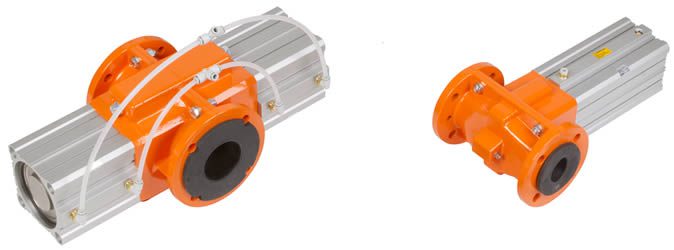Valve function:
The manual valve is connected to a hand wheel for opening and closing of the pinch valve. The closing and opening occurs by turning it clockwise for opening and counter clockwise for closing the valve.
The pneumatic valve can be configured for either normally spring closed or normally spring open, air to actuate.
Furthermore, a pinch valve with double acting cylinders is also available.
Advantages:
- It allows for a free passage, this would translate to free flow which is excellent as it would allow for more content to flow.
- Hermetic closing which basically allows for a better shut down system. This would also prevent pressure differences and problems. This would also prevent the system from building up a water hammer when the system is shut down too quickly.
- Optimum tightness allows for enough elasticity and pressure as the system would be able to sustain. This would also mean there is an amount of tensile strength to the materials allowing for minor discrepancies in the readings.
- No plugging or blocking in this sense which would mean the free flow would ensure there is a uniform flow of material.
- Easy maintenance which allows for the people to more easily manage the cleaning as well as management of material stored and let go. The issue would be to best utilize the capacity and capabilities of the pinch valve.
- It even has a rather sensible and safe security feature. Including a Safety function in the event of loss of energy/air this would mean if there is a loss of power or otherwise supply things will not malfunction too badly.
As a matter of fact it can withstand quite a lot despite looking so harmless. The device is designed to handle massive pressure in most cases. It is rather ease to use and would be a second more reasonable answer to why to incorporate in your industrial use.
Construction:
Body and actuator are designed out of aluminium which make it light and versatile. The body is made from this to make sure the valve can take such pressures and is capable of taking the stress easily. The sleeves on the other hand are designed out of various materials which are used as per what requirements they are best suited for.
Maintenance:
The sleeves are considered to be easily replaceable due to the variety of materials they are available in. This is also true for most of the components of the valve this also means that the components can be changed as per requirement. This is a technique used to decrease wear and tear for the device as well as complimenting the use.
Body:
The body is basically designed out of Aluminium making it rather versatile. This means the use can expand easily over multiple topics and materials. Aluminium would also be rather robust making it a suitable material to withstand the tests the valve would experience.
Industrial Uses:
- Pneumatic Message And Small Items Conveying Systems which employ it for pressure control.
- Ceramics
- Tannery
- Sewage Water And Mud Industry
- Cement And Fibrocement
- Pigment And Granulates
- Glass
- Marble And Granite Industry Etc
- Plastic Industry
For more information on this from the experts, click here.


